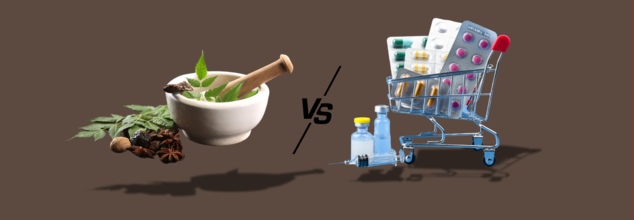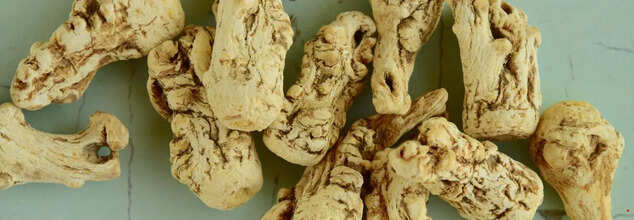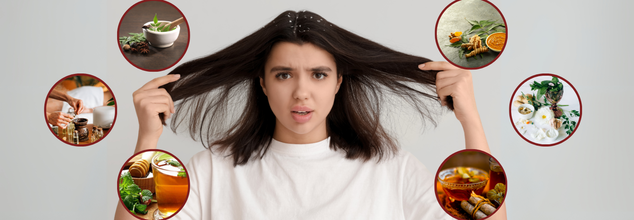
Credit: Canva
Eye Health Is Connected To Pitta Dosha—Ayurvedic Herbs That Boost Eyesight
In Ayurveda, the health of our eyes is deeply rooted in the balance of elemental forces.
Ayurvedic experts state that the body is made up of five fundamental elements (Tatvas)—Earth (Prithvi), Water (Jala), Fire (Agni), Air (Vayu), and Ether (Akasha). These elements form the foundation of the three biological energies (doshas)—Vata, Pitta, and Kapha—that govern various physiological functions.
Eyes Are Linked To Pitta Dosha
Pitta dosha, associated with the fire element, is responsible for metabolism, transformation, and heat regulation in the body. Ayurveda considers the eyes to be Pitta's primary seat. As such, prolonged exposure to harsh sunlight, UV rays, and digital screens can aggravate Pitta, leading to symptoms such as burning, redness, dryness, and inflammation in the eyes.
Here Are Ayurvedic Herbs For Eye Health
Triphala, a well-known Ayurvedic formulation made from Amalaki, Bibhitaki, and Haritaki, is highly recommended for eye care. It has cleansing and rejuvenating properties that help maintain clear vision. A Triphala eyewash can soothe irritated eyes and promote ocular health.
Yashtimadhu, or licorice root, revered for its anti-inflammatory and cooling effects, is another herb beneficial for reducing redness and irritation, especially due to UV exposure. Similarly, Ashwagandha—a potent adaptogen—can help alleviate stress and inflammation in the body, including in the eyes. “It is beneficial for maintaining overall eye health and combating the effects of UV rays,” says Dr. Mandeep Singh Basu, director of Dr. Basu Eye Hospital and Jagat Pharma.
Ghee, or clarified butter, is known in Ayurveda for its nourishing and cooling effects. Applying a few drops to the eyes at bedtime can relieve dryness and inflammation. A blend of honey and turmeric can also serve as an antimicrobial and anti-inflammatory eye drop, offering protection against infections caused by sun damage.
Other natural remedies include fennel seeds (saunf), which have soothing properties and can be used as tea or an eyewash. Coriander seeds, when boiled and cooled, can also be used to calm inflammation. Saffron, known for its antioxidant content, supports vision and protects against oxidative stress when consumed in warm milk.
Incorporating cooling agents like rose water or cucumber slices helps relieve eye strain, puffiness, and heat. Aloe vera gel, applied around the eyes, also provides a soothing effect.
Herbs such as Ginkgo biloba, chamomile, rosemary, and carrot seed oil are equally beneficial. Ginkgo improves blood circulation to the eyes, chamomile and rosemary reduce inflammation, and carrot seed oil, rich in beta-carotene, supports retinal health and vision.
With increasing exposure to screens and environmental stressors, these Ayurvedic remedies provide a holistic and gentle approach to eye care, helping to preserve one’s vision naturally while keeping the Pitta dosha in balance.

Ayurveda vs. Modern Medicine: Can Alternative Medicine Be An Effective Solution For Chronic Disease Management?
What if your daily blood pressure or diabetes pill isn't fixing the real issue—but masking it? In a world where new medicine offers instant solutions, chronic diseases are quietly spiraling out of control. But what if the answer lies in something much older? Can the ancient philosophy of Ayurveda provide more than herbal potions? Could it be the missing piece to long-term health management? With chronic diseases spiking across the world, the dialogue is moving—away from symptom masking, and toward healing at the roots. In this article, we delve into why Ayurveda, a science that dates back 5,000 years, could be the answer to unraveling chronic conditions where conventional medicine fails.
Modern medicine has certainly advanced the science of diagnostics, emergency interventions, and acute treatment. But when it comes to the management of long-term, lifestyle conditions, many experts are beginning to question: are we treating the problem—or just the symptoms?
We discussed this with Dr. Rohit Sane, an Ayurvedic physician, who told us how the revitalization and fusion of such time-tested, root-cause-based systems like Ayurveda can enable individuals to deal with chronic illness and well-being. According to Dr Rohit, "Modern medicine may offer immediate relief, but tend to leave root causes undisturbed. Ayurveda, on the other hand, works to reestablish balance at its source.
Let's see how these two medical systems differ—and if their blending could be the solution to having really sustainable health.
Is Modern Medicine a Quick-Fix Model with Short-Term Strategy
The advancement of modern medicine was heavily influenced by the pressure of the 20th century's world wars. In the World Wars, stabilizing injured soldiers as quickly as possible was the objective. This created a demand for pharmaceutical treatments that could provide instant, quantifiable outcomes—pain management, antibiotics, blood pressure pills, and so forth. Survival, not long-term healing, was the aim in such a context.
As this model seeped into civilian medicine, symptomatic relief was still the focus. The patient presented with pain; medication was prescribed to eliminate that pain. Diagnostics improved, surgeries became safer, and drugs became more targeted. But for chronic illness—where the underlying causes are lifestyle, diet, stress, and emotional health—this method tends to fail.
Consider diabetes, for example. Oral Hypoglycemic Agents (OHAs) will rapidly lower the blood sugar level, but the ACCORD trial and similar research have shown that aggressive glucose control with medication alone will raise the rate of cardiac deaths. The body, though chemically stabilized, is still imbalanced.
Does Ayurveda Provide a 360-Degree Picture of Health?
Ayurveda, an Indian medical system that is 5,000 years old, approaches things essentially differently. It considers health as a state of balance among the body, mind, and spirit. Disease is seen as a manifestation of inner imbalance-provoked by unhealthy ways of living, eating, emotional stress, and environmental toxins.
Dr. Sane describes, "In Ayurveda, healing isn't suppression. It's transformation. A patient with high blood pressure isn't given a pill. We examine their digestion, sleep, mental state, and energy levels. We tailor a program that brings internal balance, not just numbers."
Ayurvedic therapy for chronic illness commonly involves:
- Dietary changes according to constitution (dosha),
- Herbal remedies to enhance organ health,
- Mind-body practices such as yoga, pranayama (breathing), and meditation
- Detox therapies like Panchakarma, which work to remove toxins at the cellular level.
Symptom Management vs. Root Cause Healing
The difference in chronic disease management is stark. Modern medicine is great at "firefighting"—reducing a patient's perilously high blood pressure or blood sugar to a safe level. But what comes next?
Dr. Sane cautions that this symptom suppression can create a false sense of well-being. "If we just shut up the symptoms, the disease process goes on behind. Eventually, this results in complications—heart attacks, kidney failure, nerve damage.
Ayurveda, by contrast, is focused on preventing the fire from even beginning in the first place. For diabetes, that may involve enhancing digestive fire (agni), enhancing liver function, and soothing stress hormones—elements that are closely linked to blood sugar control.
Ayurveda’s Focus on Strengthening the System
One of the distinctive strengths of Ayurveda is its focus on developing what Dr. Sane terms "inner reserves." Instead of merely treating disease as it presents itself, Ayurvedic methods actively work to strengthen the body's own defense systems.
An example of this is Panchakarma—a set of detoxifying treatments aimed at the elimination of rooted metabolic waste (ama) and the restoration of the body's balance. As opposed to modern detox diets, Panchakarma acts with a combination of massage, herbal enemas, steam treatment, and specific diets, all done according to each person's condition. Its objective is not simply cleansing, but regeneration—body and mind.
Through the restoration of gut health, immune system support, and hormone regulation, Ayurveda readies the body to ward off disease rather than recover from it.
Though these systems may appear to be in conflict, Dr. Sane points out that the future of managing chronic disease is not separation but integration.
Picture using advanced diagnostics to identify disease early on, followed by Ayurvedic intervention to restore balance. We don't have to decide between them—we need to integrate their strengths," he says.
As chronic illness increases worldwide—thanks to sedentary living, ultra-processed food, and increasing stress—the demand for long-term, cause-based healing is more pressing than ever. Contemporary medicine is invaluable in emergencies, operations, and life-threatening infections. But for long-term health, particularly in the management of chronic disease, Ayurveda presents a compelling option.
Dr Rohit Madhav Sane is a Ayurvedic doctor and founder of Madhavbaug in India

Credit: Canva
Can 'Ayurvedic Blood Thinners' Really Protect You From A Stroke?
Blood thinners are vital for people at risk of heart attack or stroke, particularly those with medical conditions like congenital heart defects. These medications work in two primary ways: antiplatelets prevent blood cells from sticking together to form clots, while anticoagulants slow the clotting process itself. But with growing interest in natural health, many wonder if certain foods or herbal remedies can offer similar benefits.
Several everyday ingredients have shown potential blood-thinning effects, although the science behind them is still evolving. It's important to understand that these natural options should never replace prescribed medications without a doctor’s approval. In fact, some can interact dangerously with existing blood thinners or affect surgical outcomes.
READ: From Antiseptic To Laxative: 6 Flowers With Magical Healing Powers
Turmeric As An Ayurvedic Blood Thinner, How Does It Work?
Turmeric, a golden spice used for centuries, contains curcumin, which may help block clot formation due to its anti-inflammatory and anticoagulant properties. Similarly, ginger may reduce platelet aggregation thanks to salicylates, the same compounds found in aspirin.
Cayenne pepper also contains salicylates, but scientific evidence for its blood-thinning effect remains limited. Garlic, on the other hand, has shown mild antithrombotic activity in some studies, especially among those with high blood pressure.
Vitamin E is known to influence clotting, but excessive intake—more than 400 IU daily—can pose risks, especially when combined with prescription blood thinners. It’s best to get this vitamin through foods like almonds, sunflower seeds, and whole grains.
READ MORE: Moon Milk With Ashwagandha Is Your Ultimate Solution To Stress
What Else Could Help?
Some herbs like cassia cinnamon and dong quai contain coumarin, a natural anticoagulant. While this compound forms the basis of the drug warfarin, consuming it in large quantities from food sources can cause liver damage. Similarly, ginkgo biloba, widely used to support brain health, may interfere with clotting enzymes, though more human studies are needed.
ALSO READ: Can You Get Rid Of Dandruff Naturally? Ayurvedic Remedies To Boost Scalp Health
Grape seed extract, feverfew, and bromelain (an enzyme found in pineapple) have all shown potential in lab settings to reduce clot formation, but definitive evidence in humans remains limited. Evening primrose oil and aloe vera also contain salicylates and may affect platelet function, raising concerns when used alongside medication or before surgery.
Another emerging area of interest is melatonin, the sleep-regulating hormone. Some research suggests it may inhibit platelet activation, though it can also heighten bleeding risk when taken with blood thinners like warfarin.
What Do The Experts Say?
While these natural remedies may sound promising, experts emphasize the importance of medical supervision. Natural does not always mean safe—especially when dealing with conditions that require precise management of blood clotting.
If you're considering incorporating any of these substances—whether in food, tea, or supplement form—consult your doctor first. The goal should always be to support your health, not put it at risk.
Note: Before using any of these suggested ingredients, it is always suggested that you seek advice from your doctor first.
CHECK THIS OUT: Why Ayurveda Says Your Morning Tea Should Do More Than Just Wake You Up

(Credit-Canva)
Can You Get Rid Of Dandruff Naturally? Ayurvedic Remedies To Boost Scalp Health
Dandruff may get worse with winters, but for many it is an all year-round issue. It makes your scalp feel itchy, flaky as well as irritating. While one may think that this isn’t a big deal as it is just in our scalp, often they can create a flaky mess, showing up on clothes and may cause people to feel self-conscious. There are many ways to tackle this issue, there are dedicated shampoos, conditioners and treatments that can help you get rid of dandruff. However to do it properly, one must understand what dandruff actually is and the causes of it as well.
What is Dandruff and What Causes It?
According to Mayo clinic Dandruff happens when small pieces of dry skin flake off your scalp, often because your scalp is producing too much oil. As old skin cells die and new ones replace them, the old cells are pushed to the surface and flake off. This can make your scalp feel dry, rough, itchy, and sometimes even red. When dandruff is severe, skin cells might multiply faster, leading to more noticeable flakes and constant itching.
Several things can contribute to dandruff. Not washing your hair often enough can make it worse because oil, dirt, dead skin cells, and product buildup accumulate on your scalp. Also, your scalp can get irritated by chemicals in hair care products, causing an itchy rash. Dry skin, especially in winter when the air is less humid, can also lead to dandruff with smaller, less oily flakes. Hormones can also play a role, as they can increase oil production on the scalp, making dandruff more common in some people.
Here Are Some Ayurvedic Tips That Can Help
Bhringraj
This herb, often called the 'King of Herbs', is traditionally used to promote strong and healthy hair growth. It is also thought to help prevent hair from turning gray too early, while its properties can soothe an irritated scalp and reduce dandruff flakes by improving circulation.
Shikakai
Revered as the 'Fruit of the Hair', Shikakai is a natural cleanser that has been used for centuries. It gently removes dirt and excess oil from the scalp without stripping away its natural moisture, which can help manage dandruff and promote a healthier scalp environment for hair growth.
Neem
Widely recognized as a potent healer in traditional practices, Neem possesses strong antifungal properties that can effectively combat the fungi often associated with dandruff. It is also known for its ability to calm inflammation and reduce the persistent itching and irritation of the scalp caused by dandruff.
Tea Tree
The oil extracted from the Tea Tree is well-known for its powerful antimicrobial properties, making it a valuable ingredient in addressing dandruff. It can help to fight the microorganisms that contribute to a flaky scalp and reduce the overall severity of dandruff symptoms like itching and visible flakes.
Here are some other home remedies you can try with easily available household items and herbs.
- Soak Neem leaves overnight, make a paste with yogurt, apply for 30 mins.
- Mix egg whites with lemon juice as a hair mask.
- Gently massage baking soda into wet hair as a scrub.
- Combine Amla powder with Tulsi leaf paste, apply to scalp.
- Soak and grind Fenugreek seeds with lemon juice, apply as a paste.
- Mix Apple Cider Vinegar with water, apply to scalp.
- Soak Reetha, Shikakai, and Amla overnight, boil, strain, and use as shampoo.
- Pound Garlic with water, honey, and ginger powder, apply to scalp.
- Mix Tea Tree Oil with coconut oil, apply to scalp.
© 2024 Bennett, Coleman & Company Limited




